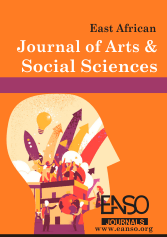Interrogating Impediments to Women Participation in Political Leadership among the Abagusii in Post-Colonial Kenya
Abstract
The trend on elective political positions in the Gusii region shows that, women have not been getting equal opportunities as their male counterparts in elective seats of members of parliament, the seats of the governor, senator and members of county assembly in the counties in Gusii region. The objective of the study was to establish challenges to women participation in political leadership among the Abagusii Community from 1963 up to 2015. The study was guided by the feminist theory. According to this theory, the discrepancies in the decision-making in societies emerge from a social framework that espouses inequality. This study was based on qualitative approach and phenomenological design. The target population was made up of 682,481 women participants from the 8 Sub-Counties and 29 wards in Kisii County from where a sample size of 422 respondents was sampled purposively. The research instruments were interviews and focused group discussions from key informants. Archival sources were used as well as secondary data from books, articles published in journals and periodicals, unpublished articles and newspapers. Piloting was carried out in Kisii County on 10% of the sample size to test dependability and credibility. The data was analyzed thematically and presented qualitatively in the narrative form. The findings of this study are that cultural factors, stereotyping of women, economic factors, political barriers, lack of husband support, stigmatization, and gender-based violence are among the factors that have contributed to low participation of women in political leadership among the Abagusii community. The recommendations of the study were change in cultural perception towards women, gender equality awareness, emphasis on women empowerment and amendment of political party policies this will bring gender equality in leadership among the Abagusii
Downloads
References
. Agbalajobi. T. D (2009). Women’s participation and the political process in Nigeria: Problem and prospects. African Journal of political Science and International Relations Vol. 4 (2)
. Bancerjee, S. (Nov, 2011).’PQ woes prompt debate in Quebec about whether women get a fair deal in politics’ The Canadian press.
. Cole S. (2011). Increasing Women’ political participation in Liberia, Challenges and potential lesson from India, Rwanda and South Africa. International Foundation of Electoral systems, Washington.
. Goetz A .M (2002)’No shortcuts to power: Constraint on Women’s political effectiveness in Uganda ‘Journal of Modern Africa studies 549-575.
. Gordon A. & Gordon D.L. (1996). Understanding Contemporary politics, 2ndedition. London: [8]. Kabira, W. and Wasamba, P. (1998). Reclaiming Women’s Space in Politics, Nairobi Centre for Gender and Development.
. Kamau (2007). Enhancing Women’s Political Participation, Nairobi; Heinrich Boll Stiftung East and Horn of Africa.
. Kamau, N. (2010). Women and Political Leadership in Kenya, Ten Case Studies. Nairobi Heinrich Bolch Foundation.
. Kanogo T. (1987). Squatters and the Roots of Mau Mau, London: James Quarry.
. Khan, T. M. (2010). Socio- cultural Determinants of Women’s Empowerment in Punjab, Pakistan. University of Agriculture, Faisalabad, Pakistan.
. Republic of Kenya, (2010b). The Population and Housing Census, Vol. 1 B, Nairobi, Kenya National Bureau of Statistics, P.133.
Neuman, W. (1998). True to Ourselves: A Celebration of Women Making a Difference SanFrancisco: Jossey- Bass Publishers.
. Nzomo, M. (1993). The Kenyan Women’s Movement in a Changing Political Context, In Khasiani and Njiro, The Women’s Movement in Kenya: AAWORD Kenya.
. Oduol W. (1993). Kenyan Women’s Movement and Women’ Political Participation in Kenya Njiro, AAWARD- Kenya.
. Oduol J. (2008). Practicing Politics: The Female side of the coin – Enhancing Women’s Political Participation in the Imminent General Elections of 2007. In Kamau. N (2008). Perspectives on Gender Discourse: Enhancing Women’s Political Participation. Nairobi: Heinrich Boll Foundation.
. Omtata O.O. (2008). The Affirmative Action Debate: Developing Winning Strategies. Nairobi: Heinrich Boll Foundation.
. Onsongo J.K. (2005). Patriarchy and the Subordination of Women among the Abagusii of Western Kenya. Department of Education, Catholic University, Monograph Series, Nairobi.
. Orodho J. (2009). Elements of Education and Social Science Research Method; Renezja Publisher, Maseno.
. Orodho A. and Kombo D. (2002). Research Methods; KU Institute of Open Learning, Nairobi
. Republic of Kenya, (2010b). The Population and Housing Census, Vol. 1 B, Nairobi, Kenya National Bureau of Statistics, P.133
. Shvedova, N. (1998). Obstacles to Women’s Participation in Parliament: Women in Parliament
. African Woman and Child Feature Service, The Status of the Kenyan Woman, issue no 37, June 2013, AWC, Nairobi.
. Convention on the Elimination of All Forms of Discrimination against women. ww. ohchr. org. Fourth World Conference on women, Beijing 1995. Un. Org.
. IPU (2012) Women in National Parliament 2011 study. Retrieved 13 March 2015 from http:// www. Ipu/ org/wmn- e/classif. Htm
. Sirleaf, E. J. (2010). Africa Women Political Participation: Lecture by H.E Ellen President of the Republic of Liberia. Retrieved March, 20, 2015, from African Women Development Fund website: http//www.awdf.org.
Copyright (c) 2024 Some Josephine Chemutai

This work is licensed under a Creative Commons Attribution 4.0 International License.




























